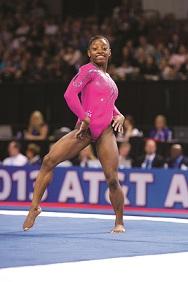

“USA Gymnastics membership has grown during the last four years, and we enjoyed a spike following the Games in London,” says Steve Penny, president and CEO of USA Gymnastics, the national governing body for gymnastics in the United States. “Our gym clubs have been reporting growth of as much as 20–30 percent, with many having waiting lists.”
Even without the Olympics boost, gymnastics is big. According to USA Gymnastics, over four million children consistently do some form of gymnastics in the United States each year, whether that is through a club, parks and recreation program, YMCA, or as part of physical education classes at school. Additionally, adults participate at the elite and collegiate levels and through recreational programs.
As the NGB, USA Gymnastics fosters the development of the sport by setting the rules and regulations for competition, offering training to member clubs and selecting the U.S. Gymnastics Team for Olympic participation, among other duties. Its programs span artistic gymnastics, rhythmic gymnastics, trampoline and tumbling and acrobatic gymnastics. USA Gymnastics sanctions 3,500–4,000 competitions each year.
Part of supporting the growth is offering positive event opportunities for new and experienced gymnasts, staff and families. USA Gymnastics looks at the big picture as well as the details when evaluating event locations to find the best fit for everyone.
“Our goal is to create win-win partnerships with every possible stakeholder when we award an event, and that includes our sponsors, the facilities, and the local gymnastics community,” says Penny. “Siting events is as much an art as it is a science, and being successful requires everyone contributing to that effort."
Successful gymnastics events begin well before the bidding process, support the needs of athletes and staff and end long after the final scores have been posted.
Biggest Isn’t Always Better
Worcester, Massachusetts is the second largest city in Massachusetts after Boston but it’s less than a third of the size. This hasn’t stopped the city from—and may have helped it in—hosting several important gymnastics events. Worcester has been host to two American Cups, most recently at the DCU Center in March of this year and the 2011 Junior Olympic Level 9 Eastern National Championships, also at the DCU Center.
 “Sports seem to travel pretty well for any type of city,” says Bob Murdock, director of sales for Destination Worcester. “Sports tend to go wherever makes sense for them for either their fan base, or their participatory base -- or if it’s a market they are trying to break into. New England is a strong gymnastics market.”
“Sports seem to travel pretty well for any type of city,” says Bob Murdock, director of sales for Destination Worcester. “Sports tend to go wherever makes sense for them for either their fan base, or their participatory base -- or if it’s a market they are trying to break into. New England is a strong gymnastics market.”
Infrastructure is key to the success of sports events and gymnastics is no exception. The cities with easiest access are going to be the most successful. For example, Worcester is within 45 minutes of both Boston and Providence, Rhode Island and convenient to two major airports. However, the city’s biggest draw tends to be regional – a distinct advantage to a sport like gymnastics that brings out spectators in droves.
“We are pretty much the center of Massachusetts, the center of New England. It works especially well. We have a big drive market, because we are easy to get to,” says Murdock.
Training Isn’t Just for Athletes
A city doesn’t necessarily have to have a long history of hosting gymnastics events to be the right fit for a championship. Pittsburgh, Pennsylvania approached the task of winning the bid for the 2014 U.S. Gymnastics Championships like any athlete would who hoped to compete at the highest levels.
“USA Gymnastics and the U.S. Gymnastics Championships in particular, we knew if we brought that in, it could be a springboard,” says Jennifer Hawkins, sports marketing director, for VisitPittsburgh. “So we began courting USA Gymnastics in 2006. We attended seminars on what they were looking for in a host city. We made sure the city, county and state and venues were on board.”
Bob Murdock has also found that it is important to establish and maintain a good relationship with the national governing body. “We are really happy with our partnership with USA Gymnastics,” he notes.

Amarillo, Texas, located in the state’s Panhandle, has a population of about 200,000, which meant that when the United States Trampoline and Tumbling Association came to town for the 2009 USTA Nationals at the Amarillo Civic Center Coliseum, the economic impact was significant. Also important was the opportunity for customizing services for the athletes, staff and family members.
“We were anticipating about 2,000 attendants and I think we ended up pretty close to that,” says Eric Miller, director of communications and digital assets for the Amarillo Convention and Visitor Council. “For our city, any group approaching 2,000 in attendance is a really great sized group.”
For the 2009 USTA Nationals, the Amarillo Convention and Visitor Council focused on the needs of the young athletes who were participating. A one-size-fits-all approach based on what works well in other markets would be a poor match for child and adolescent gymnasts.
“Our successful events—it’s true whether it’s a sporting event, a tradeshow, or a convention—it’s all about customer service,” says Miller. “We had competitors from 6–16. Obviously, customer service for them might be a little bit different. They want to know about the movies and the amusement park and other things that are good to do for that age group. They want something basic to eat and they want to hang out with their friends. They want to relax between competitions.”
Kansas City, Missouri hosted the U.S. Trampoline and Tumbling Championships in July of this year for Levels 5–10 and elite. Esther Walker-Young, destination services and special projects manager for the Kansas City Convention and Visitors Association, noted that for gymnastics, knowing the needs of the athletes also means knowing the needs of family members.
“This particular group is very family-friendly,” says Walker-Young. “You’ve got young children being escorted by their parents and because this is a competition, they are inviting their extended family. Because we’re centrally located, a lot of people could drive, so that means it will bring even more people in.”
The experience of athletes and staff while at the competition is of paramount importance, as is keeping fans busy beyond the time they spend in the bleachers or seats watching the competition. Fan expectations are keeping pace with technological changes. This is a trend that USA Gymnastics has noted.
“In our opinion, the fan experience requires every available technology resource,” says Penny. “Smartphones and tablets have replaced event programs, and the use of in-house technology is critical to the success of an event. We want our fans to enjoy the event and feel engaged in the experience.”

USA Gymnastics establishes the requirements for gymnastics facilities and knowing which facilities can meet these guidelines is critical to selecting a gymnastics event location.
Kansas City’s Municipal Auditorium was the location for the 2013 U.S. Trampoline and Tumbling Championships. The auditorium had to be able to accommodate scoring and other technologies but the greatest facility-related needs revolved around requirements such as height clearance.
“The thing that struck me the most about this group is how specific they need a facility to be,” says Walker-Young. “They have very specific specs and there is no leeway with that. The safety of their athletes is of the utmost importance.”
Jennifer Hawkins from VisitPittsburgh also found facilities capabilities to be the make-or-break factor for bidding for the U.S. Gymnastics Championships. A component key to the success of the bid was the opening of the state-of-the-art CONSOL Energy Center in 2010. “We knew we needed to wait for that venue to be open to really be competitive,” says Hawkins.
The Central Alabama Sports Commission in Montgomery, Alabama, upped its game with a new 70,000 square-foot facility capable of hosting gymnastics, volleyball, wrestling and other sports: the Multiplex at Cramton Bowl.
“Last year we had a statewide championship event here in the Multiplex,” says Dr. Ken Blankenship, executive director of the Central Alabama Sports Commission. “And we hope this year or next year to have a regional. It’s the same as hosting any event. Number one, you have to have facilities—it totally controls what you can do. We have an outstanding facility that we can adjust any way we want to.”
Engage the Community
Jennifer Hawkins with VisitPittsburgh says that part of the challenge with the 2014 U.S. Gymnastics Championships is making sure that the local community is aware of the gymnastics event. A signage package including placement of signs at the airport, throughout the downtown corridor and other locations is just one piece of a strategy designed to get the word out locally and encourage attendance and participation the week of the championships.

There’s the community that forms the volunteer and fan base for a gymnastics event but the event community is also much broader, including city and facilities partners and vendors. David Galbaugh, director of sports sales and marketing for the Greater Birmingham Convention and Visitors Bureau, found that pulling from all aspects of the community has helped Birmingham successfully host multiple Southeastern Conference Gymnastics Championships and prepare for the upcoming 2014 NCAA Women’s Gymnastics Championships, each at the Birmingham-Jefferson Convention Complex (BJCC).
We have a great partner here on all of these events—we worked with our Alabama Sports Foundation,” says Galbaugh. “Our community really embraces gymnastics, so that really helped us. We had really great partners in getting the equipment and apparatus we need,” he adds, noting that gymnastics apparatus is not something typically found at a convention center.
Don’t Forget the Off-Hours
Some competitions will allow for very little downtime. Others will present opportunities for families to get out and about and explore the local culture.
In David Galbaugh’s experience with SEC events, the day before the gymnastics championships provides the best opportunity for families to slightly extend their stay in Birmingham.
“They come in and certainly they are focused on winning championships, so the drive to compete is the most important part. But I’d say our town has plenty to do,” says Galbaugh. “SEC is basically a quick-hitting event, so you come in and have it for one day. The practice day, the day before, has typically been on a Friday, so people can watch the practice round. That has worked well here.”
For gymnastics families involved with longer competitions or who convert a short competition into a mini-vacation, activities in the off hours can help put a distinctive stamp on the overall experience. Blankenship has found that tourists in Montgomery enjoy the mix of both modern attractions and a wealth of historical sites related to the Civil War and the Civil Rights Movement.
“Our city has developed a downtown here that has first-class hotels, restaurants and places where people can get out and visit,” says Blankenship. “On top of that, the other thing we have is an incredible amount of history in our city.”

